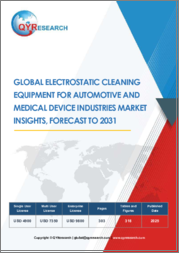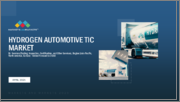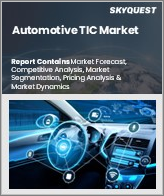
|
시장보고서
상품코드
1726990
아시아태평양의 전기자동차 배터리 시험, 검사, 인증 시장 : 차량 유형별, 스테이지 유형별, 서비스 유형별, 추진력 유형별, 배터리 유형별, 시험 파라미터 유형별, 국가별 - 분석 및 예측(2024-2034년)Asia-Pacific Electric Vehicle Battery Testing, Inspection, and Certification Market: Focus on Vehicle Type, Stage Type, Service Type, Propulsion Type, Battery Type, Testing Parameter Type, and Country-Level Analysis - Analysis and Forecast, 2024-2034 |
||||||
아시아태평양 전기자동차 배터리 시험, 검사, 인증 시장 규모는 2024년 20억 3,000만 달러에서 2034년에는 88억 9,000만 달러에 이를 전망이며, 예측 기간인 2024-2034년 CAGR 15.91%로 성장할 것으로 예측되고 있습니다.
아시아태평양 국가의 강력한 국내법, 전기자동차의 급속한 보급, 시험 기술의 지속적인 발전은 지역 산업 확대의 주요 촉진요인입니다. EV 배터리의 안전성, 신뢰성, 컴플라이언스는 철저한 테스트, 검사, 인증 서비스에 의해 확인되며 열폭주, 용량 페이드, 성능 저하 등의 우려도 줄어듭니다. 시장 확대는 아시아태평양의 지속가능성 목표 및 정부 인센티브에 의해 더욱 가속화됩니다.
| 주요 시장 통계 | |
|---|---|
| 예측 기간 | 2024-2034년 |
| 평가(2024년) | 20억 3,000만 달러 |
| 예측(2034년) | 88억 9,000만 달러 |
| CAGR | 15.91% |
전기자동차(EV)용 배터리의 시험, 검사, 인증 시장은 EV 인기 고조 및 안전 규제의 변화에 대응하는 제조업체, 서비스 제공업체, 지역 규제 당국의 움직임에 의해 아시아태평양에서 급성장하고 있습니다. 중국의 GB/T 시리즈, 일본의 JIS 인증, ASEAN의 신흥 프레임워크 등의 규격 아래, 시장은 중국, 일본, 한국, 인도의 주요 자동차 및 배터리 제조 거점에 의해 지원되고 있습니다. 이 시장에는 셀 레벨 분석, 팩 레벨 성능 테스트 및 수명 주기 테스트, 환경 스트레스 스크리닝, 종합적인 안전 학대 프로토콜(열폭주 테스트, 과충전 테스트, 단락 테스트, 파쇄 테스트)이 포함됩니다.
까다로운 인증 기한에 맞추는 것을 서두르는 OEM과 Tier 1 공급업체를 위해 기가팩토리 기반 사내랩과 전문적인 수탁시험 네트워크가 확장 가능한 용량을 제공하는 한편 ISO17025 인증과 각국의 랩 인가가 시험 결과의 일관성 및 신뢰성을 보장합니다. 처리량, 정밀도, 비용 효율성은 고 처리량 자동 리그, AI 주도 진단, 로컬 듀티 사이클로 교정된 디지털 트윈 시뮬레이션, 고도의 열량 측정 등의 기술적 진보에 의해 개선되고 있습니다. 현장 거치형 시험 인프라 투자는 세컨드라이프 용도를 지원하는 순환경제 규제, 정부 인센티브, 국내 전지 생산을 지원하는 녹색자금 프로그램에 의해 추진되고 있습니다.
큰 진전에도 불구하고, 선진 장비의 고가의 비용, 아시아태평양 국가 간의 다른 규제 환경, 고도로 숙련된 기술자의 부족, 인프라의 한계(전력 안정성, 냉각수, 실험 공간)와 같은 장애는 여전히 존재합니다. 그러나 아시아태평양의 각국 정부가 배터리 공급망의 회복력 향상, 보다 엄격한 안전 규칙의 시행, 적극적인 EV 목표의 설정을 목표로 하고 있기 때문에 이 산업은 2030년까지 2자리 성장을 계속할 것으로 예측됩니다.
동향
- 형식 승인 프로세스를 합리화하기 위한 지역 규격의 조화(중국 GB/T, 일본 JIS, ASEAN).
- AI를 활용한 진단, 디지털 트윈 시뮬레이션, 높은 처리량 자동 시험 장치의 채용.
- 보다 신속한 턴어라운드를 위한, 현장의 기가팩토리 실험실 및 전문가별 수탁 시험 네트워크의 확대.
- 차세대 화학물질을 위한 고도 열량 측정과 실시간 열폭주 모니터링의 통합.
촉진요인
- 중국, 인도, 일본, 동남아시아에서 EV 판매의 폭발적 확대.
- 정부의 인센티브, 그린 자금 제도, 국내 전지 의무화에 의해 현지 랩에 대한 투자가 활성화
- 인증 일정의 위험을 줄이고 국경을 넘어 물류 비용을 줄이기위한 OEM 및 Tier 1 공급업체의 전략.
- 건전성 평가와 재이용 인증을 필요로 하는 세컨드 라이프 배터리 용도의 출현.
과제
- 최첨단 기기 및 시설 건설을 위한 고액의 자본 지출.
- 세분화된 지역규제 및 진화하는 규격이 시장 횡단적인 컴플라이언스 복잡화 초래
- 배터리 시험 프로토콜을 전문으로 하는 숙련 엔지니어나 기술자 부족
- 인프라 제약-주요 거점에서의 전력 안정성, 냉각수 공급, 실험실 공간 부족.
이 보고서는 아시아태평양의 EV 배터리 테스트, 검사 및 인증 시장에 대한 귀중한 인사이트를 제공하며 전략적 의사 결정과 시장 예측에 필요한 지식을 기업에 제공합니다. 본 보고서는 신흥 기술, 규제 변화, 경쟁 역학을 포괄적으로 분석하여 기업이 성장 기회를 파악하고 진화하는 업계의 요구에 맞게 제품을 제공할 수 있도록 지원합니다. 게다가 주요한 시장 참가 기업, 그 전략, 비즈니스 모델을 상세하게 조사해, 경합 정세 속에서 기업이 우위에 서는 것을 가능하게 합니다. 규제와 컴플리언스에 관한 인사이트도 커버하고 있어, 국제적인 시험 규격, 안전 규제, 지속 가능성 대처에 대해 상세한 평가를 실시해, 시장에 대한 대응을 확실하게 하고 있습니다. 게다가 지역별 및 부문별 분석에 의해, 다양한 시장의 성장 패턴, 과제, 기회를 분명히 해, 과녁을 좁힌 시장 참가 및 확대 전략을 서포트합니다. 본 보고서의 조사 결과를 활용함으로써 기업은 혁신을 추진하고, 업무 효율을 향상시키며, 진화하는 EV 배터리 시험 및 인증 정세에서 경쟁 우위를 확보할 수 있습니다.
본 보고서에서는 아시아태평양의 전기자동차 배터리 시험, 검사, 인증 시장에 대해 조사했으며, 시장 개요와 함께 차량 유형별, 스테이지 유형별, 서비스 유형별, 추진력 유형별, 배터리 유형별, 시험 파라미터 유형별, 국가별 동향 및 시장 진출기업 프로파일 등의 정보를 제공합니다.
목차
주요 요약
제1장 시장 : 업계 전망
- 동향 : 현상과 장래에 대한 영향 평가
- 배터리 시험에 있어서의 디지털 트윈의 도입
- 무선 및 자동 테스트 시스템
- 배터리 시험에서 AI 및 머신러닝
- 투명한 인증 및 테스트를 위한 블록체인
- 배터리 검사에서 자동화 및 로봇 공학
- 차세대 EV 배터리용 선진 재료 시험
- 배터리 인증을 위한 시뮬레이션 및 예측 분석의 혁신
- 재사용 배터리 테스트 및 재활용 용도
- 공급망 개요
- 연구개발 리뷰
- 규제 상황
- 서비스 개요
- 시험
- 검사
- 인증
- COVID-19의 업계에 대한 영향
- 시장 역학 개요
제2장 지역
- 지역의 요약
- 아시아태평양
- 지역 개요
- 시장 성장 촉진요인
- 시장 성장 억제요인
- 중국
- 일본
- 한국
- 인도
- 기타
제3장 시장-경쟁 환경 및 기업 프로파일
- 향후 전망
- 지리적 평가
- 경쟁 구도
- 기업 프로파일
- The Hong Kong Standards and Testing Centre Limited
- ATIC(Guangzhou) Co., Ltd.
제4장 조사 방법
AJY 25.05.26Introduction to Asia-Pacific Electric Vehicle Battery Testing, Inspection, and Certification Market
The Asia-Pacific EV battery testing, inspection, and certification market is projected to reach $8.89 billion by 2034 from $2.03 billion in 2024, growing at a CAGR of 15.91% during the forecast period 2024-2034. Strong national laws in APAC countries, the rapid use of electric vehicles, and ongoing advancements in testing technologies are major drivers of regional industry expansion. EV battery safety, dependability, and compliance are confirmed by thorough testing, inspection, and certification services, which also reduce concerns like thermal runaway, capacity fade, and performance loss. Market expansion is further accelerated by APAC's sustainability goals and government incentives.
Market Introduction
| KEY MARKET STATISTICS | |
|---|---|
| Forecast Period | 2024 - 2034 |
| 2024 Evaluation | $2.03 Billion |
| 2034 Forecast | $8.89 Billion |
| CAGR | 15.91% |
The market for electric vehicle (EV) battery testing, inspection, and certification is growing quickly in Asia-Pacific as manufacturers, service providers, and regional regulators react to the growing popularity of EVs and changing safety regulations. Under standards like China's GB/T series, Japan's JIS certifications, and emerging ASEAN frameworks, the market is anchored by major automotive and battery manufacturing hubs in China, Japan, South Korea, and India. It includes cell-level analyses, pack-level performance and lifecycle testing, environmental stress screening, and comprehensive safety-abuse protocols-thermal-runaway, overcharge, short-circuit, and crush tests.
For OEMs and Tier 1 suppliers rushing to meet strict certification deadlines, gigafactory-based in-house laboratories and specialised contract-testing networks offer scalable capacity, while ISO 17025 accreditation and national laboratory authorisations guarantee consistency and credibility in test results. Throughput, accuracy, and cost efficiency have been improved by technological advancements such as high-throughput automated rigs, AI-driven diagnostics, digital-twin simulations calibrated to local duty cycles, and sophisticated calorimetry. Investments in on-site stationary testing infrastructure are being driven by circular economy regulations that support second-life applications, government incentives, and green funding programs that support domestic battery production.
Despite significant progress, obstacles still exist, including the expensive cost of advanced equipment, the disparate regulatory environments across APAC nations, the scarcity of highly skilled technical personnel, and infrastructure limitations (power stability, cooling water, and lab space). However, the industry is expected to continue growing at double-digit rates through 2030 as governments in the Asia-Pacific region aim to improve battery supply chain resilience, enforce stricter safety rules, and set aggressive EV targets.
Market Segmentation
Segmentation 1: By Vehicle Type
- Passenger Vehicles
- Commercial Vehicles
Segmentation 2: By Stage Type
- Pre-Production Testing
- Post-Production Testing
Segmentation 3: By Battery Type
- Lithium-Ion
- Lead Acid
- Others
Segmentation 4: By Service Type
- Testing
- Inspection
- Certification
Segmentation 5: By Sourcing Type
- In-House
- Outsourced
Segmentation 6: By Propulsion Type
- Battery Electric Vehicles (BEVs)
- Plug-In Hybrid Electric Vehicles (PHEVs)
- Hybrid Electric Vehicles (HEVs)
Segmentation 7: By Testing Parameter Type
- Electrical Testing
- Mechanical Testing
- Thermal Testing
- Electromagnetic Compatibility (EMC) Testing
- Chemical Testing
- Others
Segmentation 8: By Region
- Asia-Pacific: China, Japan, India, South Korea, and Rest-of-Asia-Pacific
APAC Electric Vehicle Battery Testing, Inspection, and Certification Market Trends, Drivers and Challenges
Trends
- Harmonization of regional standards (China GB/T, Japan JIS, ASEAN) to streamline type-approval processes.
- Adoption of AI-enhanced diagnostics, digital-twin simulations and high-throughput automated testing rigs.
- Expansion of on-site gigafactory laboratories and specialist contract-testing networks for faster turnaround.
- Integration of advanced calorimetry and real-time thermal-runaway monitoring for next-gen chemistries.
Drivers
- Explosive growth in EV sales across China, India, Japan and Southeast Asia driving testing demand.
- Government incentives, green-funding schemes and domestic battery mandates bolstering local lab investments.
- OEM and Tier 1 supplier strategies to de-risk certification timelines and reduce cross-border logistics costs.
- Emergence of second-life battery applications requiring state-of-health assessments and repurposing certifications.
Challenges
- High capital expenditure for cutting-edge equipment and facility build-outs.
- Fragmented regional regulations and evolving standards complicating cross-market compliance.
- Limited pool of skilled engineers and technicians specialized in battery testing protocols.
- Infrastructure constraints-power stability, cooling water supply and lab space shortages in key hubs.
How can this report add value to an organization?
This report provides invaluable insights into the APAC EV battery testing, inspection, and certification market, equipping organizations with the knowledge needed for strategic decision-making and market forecasting. It comprehensively analyzes emerging technologies, regulatory shifts, and competitive dynamics, helping businesses identify growth opportunities and align their offerings with evolving industry needs. Additionally, the report provides an in-depth examination of key market players, their strategies, and business models, enabling organizations to stay ahead in a competitive landscape. Regulatory and compliance insights are also covered, offering a detailed assessment of international testing standards, safety regulations, and sustainability initiatives to ensure market readiness. Furthermore, regional and segmentation analyses shed light on growth patterns, challenges, and opportunities across different markets, supporting targeted market entry and expansion strategies. By leveraging the findings of this report, businesses can drive innovation, enhance operational efficiency, and secure a competitive advantage in the evolving EV battery testing and certification landscape.
Table of Contents
Executive Summary
Scope and Definition
1 Market: Industry Outlook
- 1.1 Trends: Current and Future Impact Assessment
- 1.1.1 Adoption of Digital Twins in Battery Testing
- 1.1.2 Wireless and Automated Testing Systems
- 1.1.3 AI and Machine Learning in Battery Testing
- 1.1.4 Blockchain for Transparent Certification and Testing
- 1.1.5 Automation and Robotics in Battery Inspection
- 1.1.6 Advanced Material Testing for Next-Gen EV Batteries
- 1.1.7 Innovations in Simulation and Predictive Analytics for Battery Certification
- 1.1.8 Testing of Second-Life Batteries and Recycling Applications
- 1.2 Supply Chain Overview
- 1.2.1 Key Stakeholders
- 1.2.1.1 Raw Material Testing
- 1.2.1.2 Battery Manufacturing and Integration
- 1.2.1.3 Testing and Certification Service Providers
- 1.2.1.4 End-Use Industries
- 1.2.2 Value Chain Analysis
- 1.2.3 Pricing Forecast
- 1.2.1 Key Stakeholders
- 1.3 Research and Development Review
- 1.3.1 Patent Filing Trend (by Country and Company)
- 1.4 Regulatory Landscape
- 1.5 Services Overview
- 1.5.1 Testing
- 1.5.1.1 Performance Testing
- 1.5.1.2 Durability Testing
- 1.5.1.3 Electrical Testing
- 1.5.1.4 Thermal Testing
- 1.5.1.5 Abuse and Crash Testing
- 1.5.1.6 Non-Destructive Testing (NDT)
- 1.5.2 Inspection
- 1.5.2.1 Visual Inspection
- 1.5.2.2 Safety Inspection
- 1.5.2.3 Quality Control Inspection
- 1.5.3 Certification
- 1.5.3.1 Product Certification (ISO, IEC)
- 1.5.3.2 Safety and Compliance Certification
- 1.5.3.3 Environmental Certification (RoHS, WEEE)
- 1.5.3.4 Regulatory Certification
- 1.5.1 Testing
- 1.6 Impact of COVID-19 on the Industry
- 1.7 Market Dynamics Overview
- 1.7.1 Market Drivers
- 1.7.1.1 Rising Electric Car Sales Accelerating Demand for Reliable and Certified Batteries
- 1.7.1.2 Growing Emphasis on Safety Standards for EV Batteries
- 1.7.2 Market Challenges
- 1.7.2.1 High Costs of Advanced EV Battery Testing Equipment and Facilities
- 1.7.2.2 Lack of Standardized Testing and Certification Requirements for EV Batteries across Markets
- 1.7.3 Market Opportunities
- 1.7.3.1 Increasing Development of Next-Generation EV Batteries
- 1.7.3.2 Expanding Market for Second-Life Applications and Recycling of EV Batteries
- 1.7.1 Market Drivers
2 Regions
- 2.1 Regional Summary
- 2.2 Asia-Pacific
- 2.2.1 Regional Overview
- 2.2.2 Driving Factors for Market Growth
- 2.2.3 Factors Challenging the Market
- 2.2.3.1 Application
- 2.2.3.2 Product
- 2.2.4 China
- 2.2.4.1 Application
- 2.2.4.2 Product
- 2.2.5 Japan
- 2.2.5.1 Application
- 2.2.5.2 Product
- 2.2.6 South Korea
- 2.2.6.1 Application
- 2.2.6.2 Product
- 2.2.7 India
- 2.2.7.1 Application
- 2.2.7.2 Product
- 2.2.8 Rest-of-Asia-Pacific
- 2.2.8.1 Application
- 2.2.8.2 Product
3 Markets - Competitive Landscaped and Companies Profiled
- 3.1 Next Frontiers
- 3.2 Geographical Assessment
- 3.3 Competitive Landscape
- 3.4 Company Profiles
- 3.4.1 The Hong Kong Standards and Testing Centre Limited
- 3.4.1.1 Overview
- 3.4.1.2 Top Services/Service Portfolio
- 3.4.1.3 Top Competitors
- 3.4.1.4 Target Customers
- 3.4.1.5 Key Personnel
- 3.4.1.6 Analyst View
- 3.4.1.7 Market Share, 2023
- 3.4.2 ATIC (Guangzhou) Co., Ltd.
- 3.4.2.1 Overview
- 3.4.2.2 Top Services/Service Portfolio
- 3.4.2.3 Top Competitors
- 3.4.2.4 Target Customers
- 3.4.2.5 Key Personnel
- 3.4.2.6 Analyst View
- 3.4.2.7 Market Share, 2023
- 3.4.1 The Hong Kong Standards and Testing Centre Limited
4 Research Methodology
- 4.1 Data Sources
- 4.1.1 Primary Data Sources
- 4.1.2 Secondary Data Sources
- 4.1.3 Data Triangulation
- 4.2 Market Estimation and Forecast



















